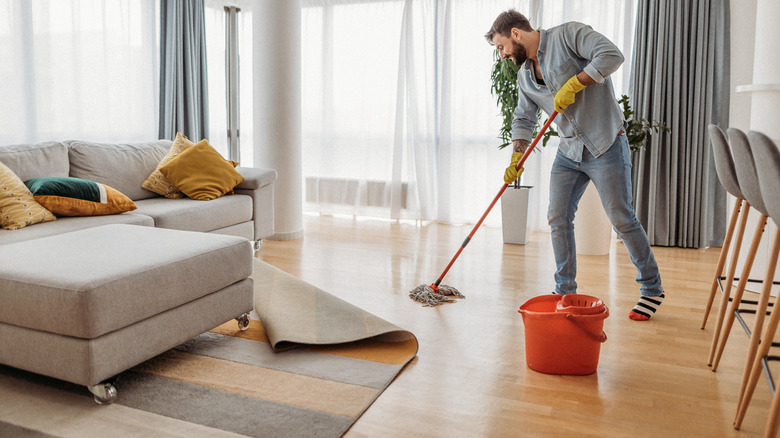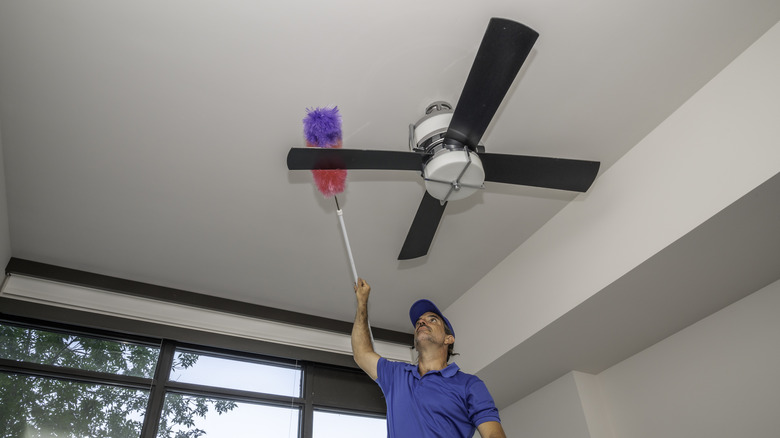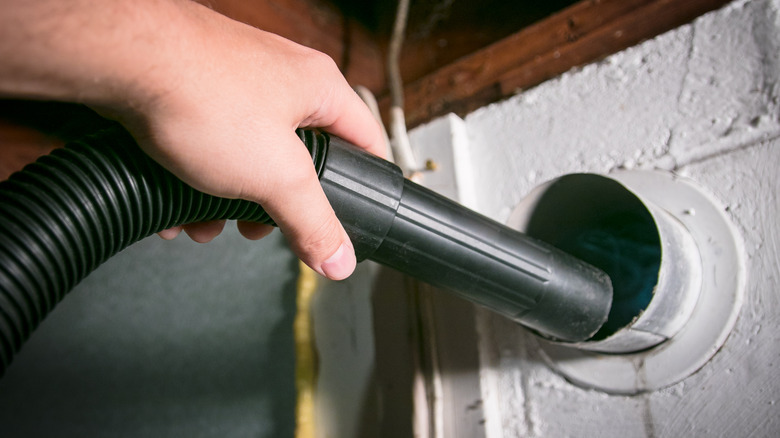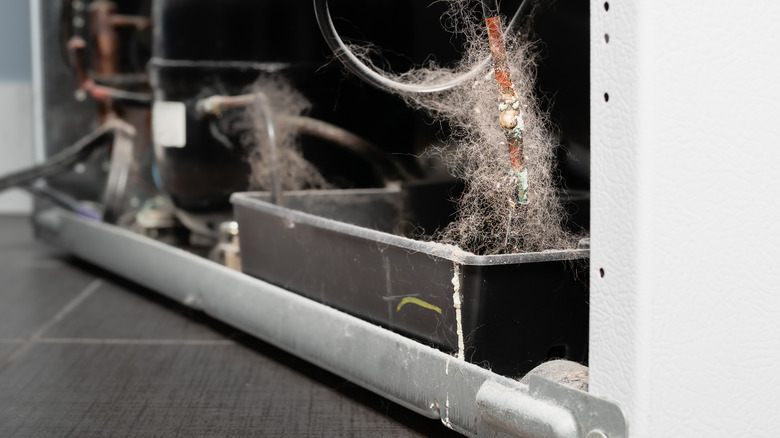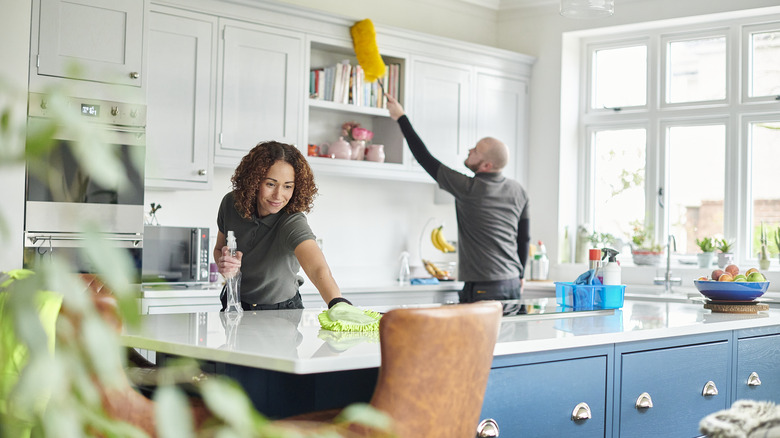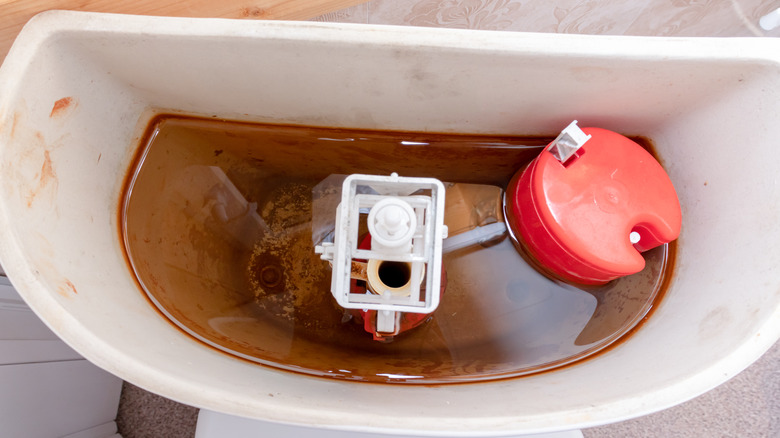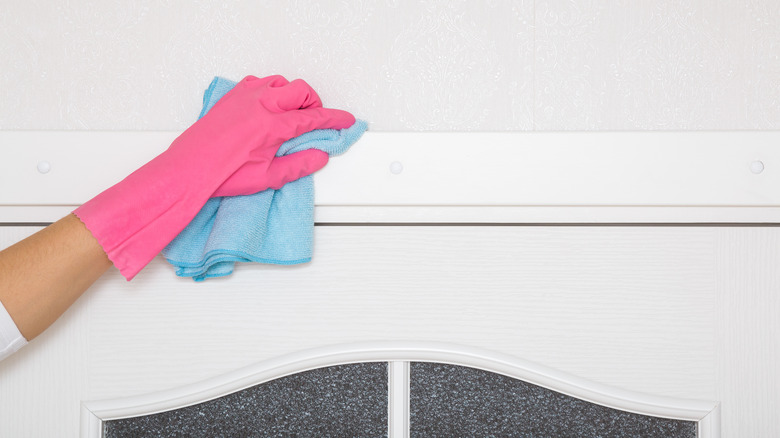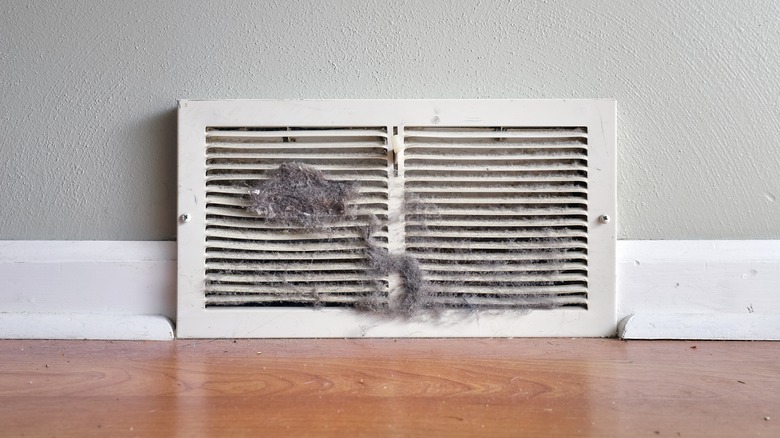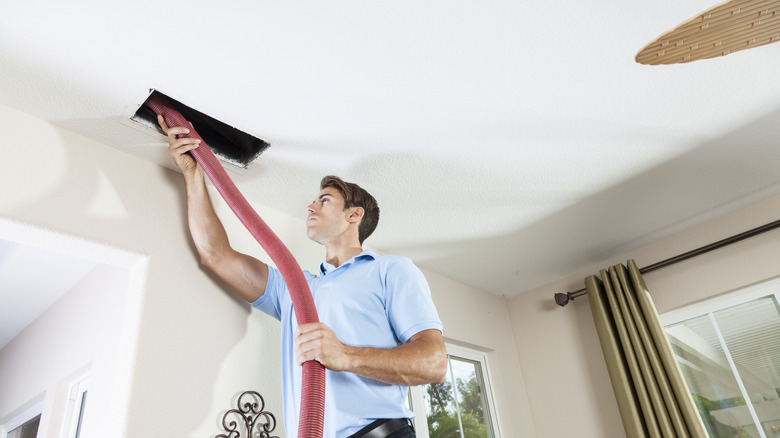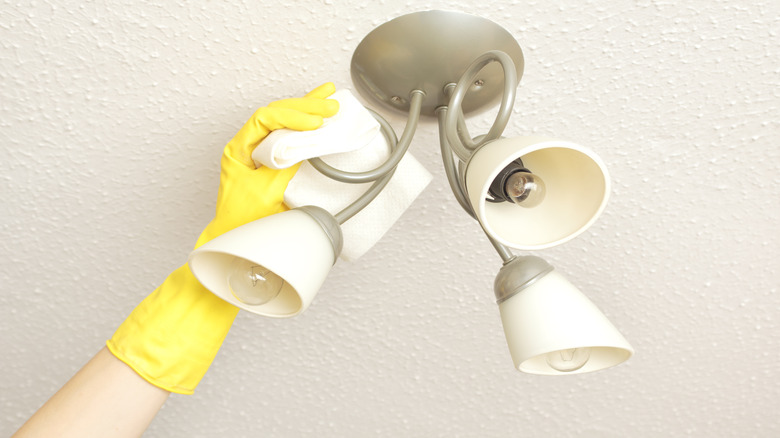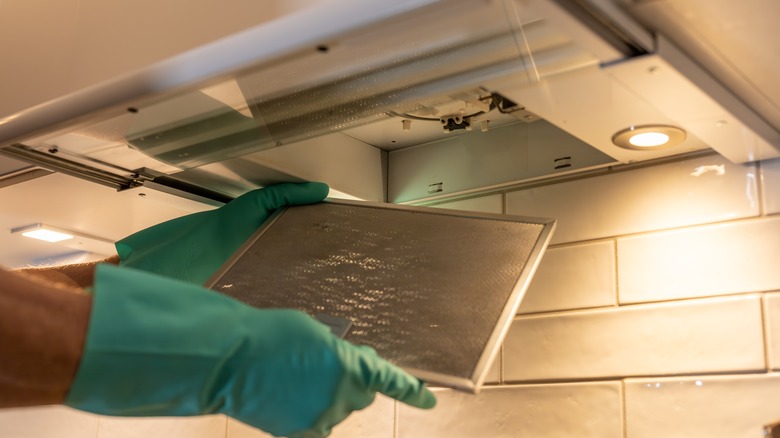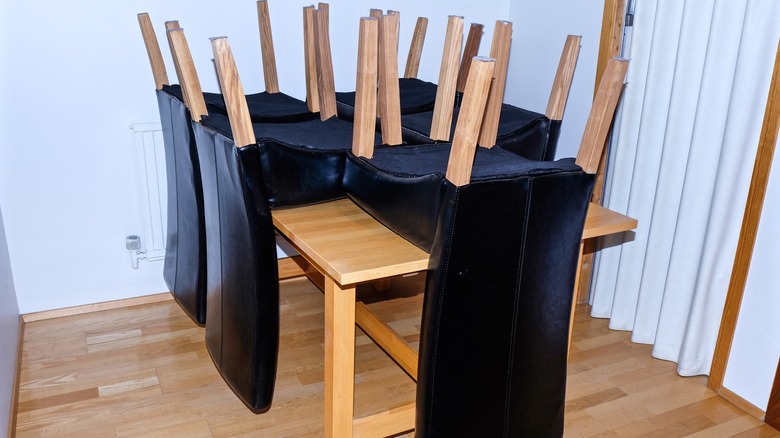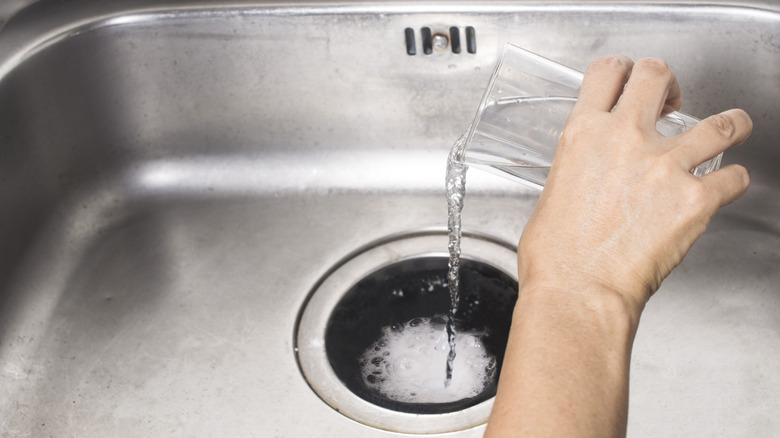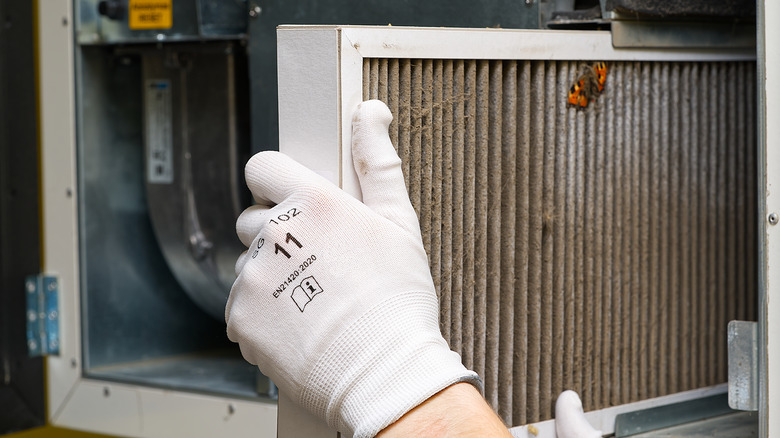Out Of Sight, Out Of Mind? The 14 Most Likely Places You Are Forgetting To Clean
You might be diligent about cleaning things in your family room weekly, wiping the kitchen countertops after every meal, and scrubbing the bathroom and shower regularly. However, while it's important to maintain these rooms for a sparkling house, there might be a few places in your home you're forgetting to clean. A prime example of this is any surfaces that are out of sight. Since they're above or beyond eye level, they usually fly under the radar and seldom make it to your comprehensive cleaning checklist.
For instance, while you might wipe your kitchen cabinet's exterior every week or two (maybe more if they get splattered), it might not even cross your mind to check the top and dislodge the accumulated dust. Similarly, hard-to-reach areas like under your bed, sofa, and appliances are more often than not overlooked as well. So, to ensure you don't fall into the tempting trap of an "out of sight, out of mind" mindset during your cleaning sessions, we've rounded up a list of 14 places you are most likely forgetting to clean and how often you should clean them. This handy list will help you avoid unwelcome surprises, like mold and critters in hibernation, down the road.
1. Don't ignore your ceiling fans
Ceiling fans are essential household appliances but are seldom cared for due to their close proximity to the fifth wall (ceiling). However, the whirling blades attract dust, dirt, soot, and pollen. These particles settle on the blades, weighing them down and reducing their efficiency. Plus, the rotating blades distribute the accumulated dust around your home, negatively affecting the indoor air quality. Don't ignore your ceiling fans and dust them at least once a week to keep them dirt-free and running efficiently. Additionally, clean your ceiling fans with soapy water every month to keep them looking new.
2. Clogged dryer vents are a fire hazard
According to the NFPA, dryers lead to almost 16,000 fires annually. The unassuming lint, dust, and fibers are often the first things to ignite. Since lint build-up blocks air movement, it often causes the dryer to overheat and malfunction, resulting in unwarranted fires. A dryer with a clogged vent will also have to work overtime to dry your clothes, drawing more electricity in the process. So, make it a habit to clean your dryer vents annually. However, you might need to clean them more often if you're a family of four (or more), have pets, and use the dryer regularly.
3. Clean behind appliances to keep them running smoothly
You might be diligent about keeping your appliances like fridges, dishwashers, washing machines, dryers, and ovens in tip-top shape. But how often do you clean behind (or underneath) them? Accumulated dust and debris can coat the coils and back of the appliances, restricting their airflow. This forces them to consume more energy to run, leading to higher electricity bills. Plus, the unhygienic environment draws in pesky pests like ants, cockroaches, and rats and decreases the lifespan of your expensive appliances. It's a good practice to clean behind your oven every month, refrigerator every quarter, washer and dishwasher biannually, and dryer annually.
4. The top of your kitchen cabinet harbors grime
While you might think that the top of your kitchen cabinets might not harbor much dirt and grease due to their vantage point, you'd be wrong. If there's a gap between your ceilings and cabinets, there's a high probability the surface is coated with grime. To dislodge the dust and keep the top of your cabinets spick and span, deep clean them every couple of months. You can do this with a soft cloth and a degreaser to remove any grime that has accumulated. More regularly, you can also simply dust above the cabinets.
5. Inspect the toilet tank for mold and rust
Even if you religiously clean your toilet to give disease-causing germs the boot, you might be neglecting the toilet tank. However, ignoring the water cistern can lead to mineral build-up. This can interfere with the flush valve, especially if you live in an area with hard water. Additionally, the metal parts can develop rust, the tank's insides can discolor, and mold and mildew can set up shop. This deadly concoction would give off a foul smell and invite bacteria to the party. To ensure the tank lasts long, clean it biannually. While you're at it, don't forget to wipe the tank's exterior.
6. Dust above door frames
If you're thinking of hiding your spare set of keys above the door frames, you better clean them first unless you want them and your hands to get caked in dust. These blindspots are the perfect example of "out of sight, out of mind," and therefore can harbor dust, dirt, bacteria, and critters. As such, take a pass along the frame the next time you clean your interior (at least once annually) or exterior (monthly) doors. The good news? The cleaning isn't too effort-intensive since it's one of the unexpected things you can clean with a Swiffer. Similarly, clean above mirrors and windows, too.
7. Keep your air vents dust-free
Air vents are an important part of your HVAC system, controlling the flow of air around your home. But they often don't make it to a homeowner's cleaning list. However, these vents accumulate dirt, dust, and debris over time. If left untreated, they draw excessive power, shooting up your energy bills. A dirty air vent will also distribute dust around the house and is the ideal spot for mold and mildew to develop and multiply, leading to poor indoor air quality. Luckily, you should only have to clean your air vents every two to five years, unless you notice lots of build-up.
8. Dirty air ducts will degrade your home's indoor air quality
Air ducts are another essential part of your home's HVAC system and are responsible for circulating air inside. Since these ducts are the ideal hiding spot for dust, dirt, pet dander, spider cobwebs, hair, and mold, it's best to clean them regularly to maintain indoor air quality and keep pollutants out. If the ducts are dirty, this will also put a strain on your HVAC system, shoot up your electricity bills, and lead to a foul smell. To keep your air ducts in tip-top shape, the NADCA recommends having them looked at annually by professionals and cleaned as directed.
9. Uncover the shine of your ceiling lights
Just like with ceiling fans, ceiling lights are often ignored due to their above-eye-level placement. However, that doesn't mean they don't attract dust and dirt. Besides dulling their shine and minimizing the light they give off, dirty light fixtures also have a short lifespan. To ensure a high ROI (return on investment), dust all your ceiling light fixtures every week. Additionally, give them a deep clean annually or biannually, depending on how dirty they get.
10. Wipe your stovetop vent hood for maximum efficiency
A stovetop vent hood is responsible for inhaling the cooking smoke and grease in your kitchen and moving them out of your house. This nifty device helps maintain the air quality inside and removes gross odors (fish, anyone?). But these hoods get dirty and clogged over time and need some sprucing up to function efficiently. With this in mind, try to clean your stovetop's vent hood, including the filter, once monthly. However, if you don't cook often, you can get away with cleaning them every quarter or so.
11. Give your outdoor light fixtures some TLC
You spend hours choosing the perfect outdoor light fixtures to brighten your home's exterior. However, forgetting all about them after installation will make your home look run-down. While the dirt, grime, and bugs can add to the eerie atmosphere on Halloween, it'll cast your house in poor light the rest of the year. This is why you should clean your outdoor light fixtures at least twice (or thrice if they get dirty sooner) annually. Whichever frequency you land on, try scheduling a cleaning session before winter. Don't forget to wipe the fixture's exteriors, like glass coverings, to keep your outdoor lights shining.
12. Check the underside of surfaces for a cleaner home
You might vacuum the floor beneath your tables, countertops, cabinets, and other surfaces to maintain a dust-free home. Yet, how many times do you bend down to peer at, let alone clean, the underside of your dining table or countertop? Unsurprisingly, the underside becomes a home for dust, dirt, elaborate cobwebs, and grime. Simply put, it's one of the top places in your home you're forgetting to dust. So, check the underside of the surfaces in your home and clean them whenever you wipe the top.
13. Regularly clean your garbage disposal unit
Once you put a garbage disposal unit under your kitchen sink, you have little reason to check on it or worry about its cleanliness — that is, as long as it's functioning well and there are no blockages. But if your kitchen has been giving off a strange smell, it's time to inspect your garbage disposal unit. The stuck food scraps degrade over time and invite bacteria, giving off a foul stench. A simple solution is to clean your garbage disposal unit every week. If you're diligent about not putting smelly food particles down the drain, clean the unit once or twice a month.
14. Monitor your HVAC's air filter
Your HVAC system is outfitted with an air filter that captures dust, dirt, pollen, pet hair, and other air pollutants so you breathe in cleaner air. Since they're your first (and oftentimes only) layer of defense against microscopic pollutants, monitoring them is necessary to ascertain they aren't too dirty to do their job effectively. This is why many recommend cleaning or replacing your HVAC air filters about once every three months, depending on your filter type and how filthy it is. For instance, disposable filters can't be used once saturated and require a replacement, unlike permanent ones with fiberglass frames.
